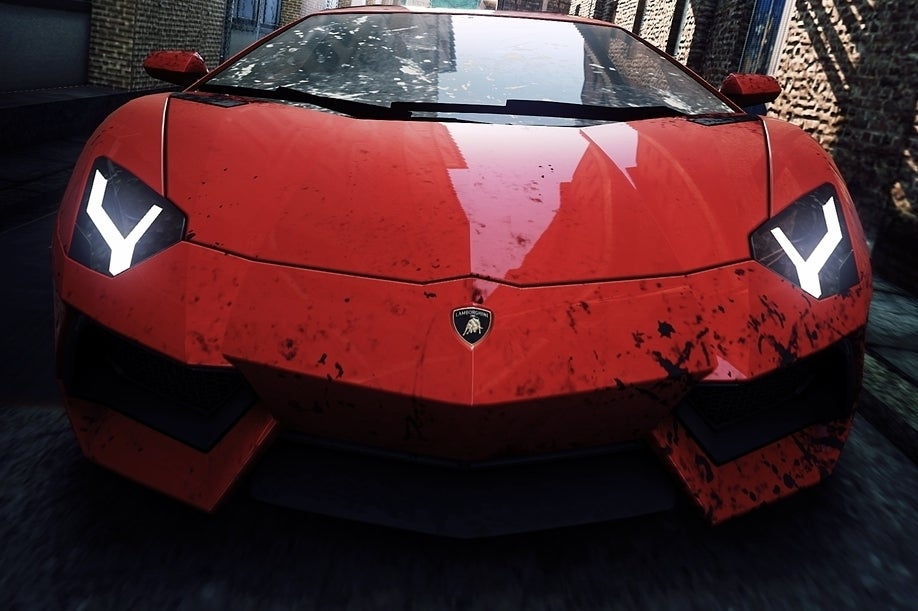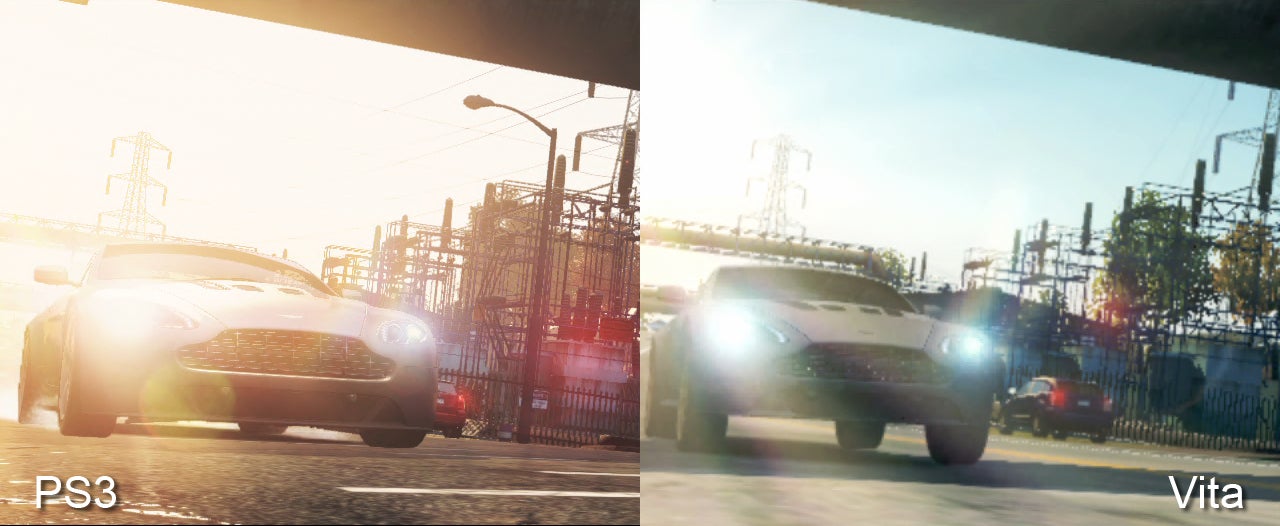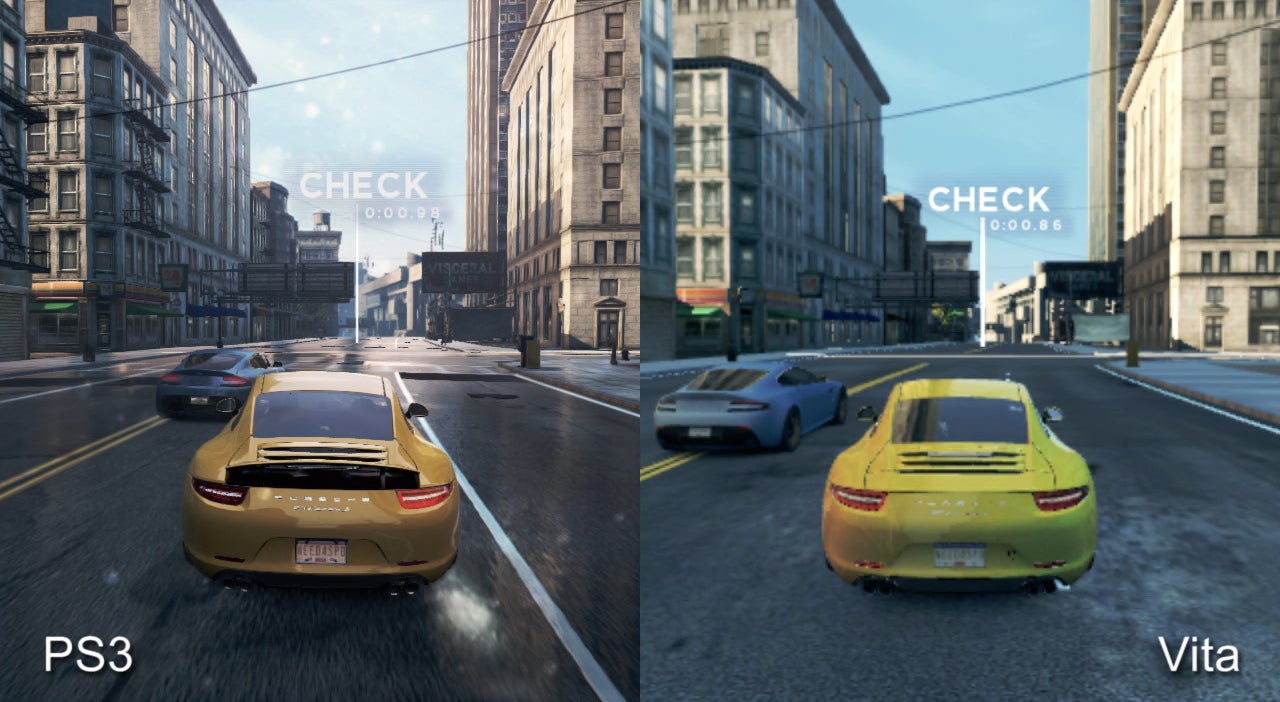Need for Speed Most Wanted Ps Vita Review
Demand for Speed: Almost Wanted vs. PlayStation Vita
How well can cutting-edge games run on Sony'southward handheld? Digital Foundry talks to Criterion Games.

In an ongoing series of articles, Digital Foundry takes an in-depth look at the near high-profile PlayStation Vita releases, talking with the developers and gaining new perspective on what it's like creating games for Sony's brilliant - but underperforming - handheld. In this 2d instalment, our focus is Need for Speed: Most Wanted, ane of the nigh fascinating games available for the platform. Criterion Games' objective here was ambitious: to incorporate PlayStation Vita into the cross-platform development workflow of what turned out to exist ane of the most technologically avant-garde electric current-gen games on the market. As yous might look from the Guildford studio, the result isn't simply a great game but a remarkable technological achievement.
"For the first fourth dimension in the handheld's history, we can happily transpose all of our praise and criticism of a home console game to the PlayStation Vita version - which is something of an occasion in itself," wrote Martin Robinson in the Eurogamer review. "Much of the credit must go to Criterion, which handled the Vita version of Almost Wanted itself. Perchance unsurprisingly, given the studio'south pedigree, it's done an impeccable job... Understandably, it's taken something of a visual hit, but information technology's never enough to undermine the incredible accomplishment or the immense novelty of having a faithful handheld port 24-hour interval and date with its bigger cousin."
A lot of this article is going to hash out that "visual hitting", so information technology'southward of import to put Vita Most Wanted into context. Your PlayStation three or Xbox 360 - assuming they are the latest models - draw something like 70 to 80 watts of juice from the mains. In contrast, PlayStation Vita uses merely five per cent of that total, burning up around 3.5 to 4W during gameplay. Even upwards against the highly efficient Wii U at 33W, nosotros're talking about a tiny amount of physical power available to power a triple-A game designed for much more capable systems. While efficiency in rendering has come on by leaps and premises over the years, that's still a huge gap to close. To tell the truth, it can't be closed, and compromises need to be made. Most Wanted is one of five renditions of the same game produced by Criterion, and the team simply didn't have the luxuries open to developers of first-party Vita titles like Uncharted: Golden Completeness and WipEout 2048, where the game pattern and core rendering engineering science could be shaped around the strengths and weaknesses of the mobile hardware.
"The Vita version is the aforementioned game," confirms Idries Hamadi, technical director at Criterion Games. "There'southward a machine in the depths of our basement somewhere that's syncing our Perforce and building all five versions of the game every 3 minutes. It is not a bespoke version, it's a splendid platform for all of them."
"The Vita version is the same game. There's a machine in the depths of our basement somewhere that's syncing our Perforce and building all five versions of the game every three minutes."
The comparison video spells that out. The exact same methodology we employ for all of our caput-to-caput videos - frame-accurate excerpts running adjacent - works here because the game logic is finer identical, the visuals drawn from the same cadre asset base, the handling model built effectually the same physics.
Game content is also a match between the handheld and panel versions - the open world map's the same, the collectables (or rather, the "smashables") are the same, the car roster is identical. However, the visual compromises are apparent in the comparison. In terms of processing ability, Vita occupies an undefined space somewhere betwixt PS2 and PS3 - while less aggressive electric current-gen games tin can exist replicated very closely on PS Vita, a top-of-the-line feel like Demand for Speed: Near Wanted needs a unlike kind of arroyo.
Then what was Benchmark's methodology in getting to grips with the Vita hardware? What was the process in discerning whether Sony's handheld could deal with a game designed primarily with electric current-generation panel hardware in mind?
"There's a few different aspects to that kind of operation," Hamadi reveals. "One is an on-paper analysis - but we didn't put much stock in that because nosotros understood that once we peeled back the first layer of 'allow'due south just look at numbers' yous're talking virtually very different beasts and the numbers y'all've got only go so far. Information technology's like we said with Wii U - nosotros got some running software, we pulled out everything we possibly could to get a real stripped-down version of the game."
After that, it becomes an exercise in putting back in equally much every bit possible, optimising and adding more. Where some systems are simply not a good fit for the handheld, alternatives are produced. Resolution aside, lighting is the biggest divergence betwixt the mobile version and the full-fatty console edition.
"Nosotros go it to the point where information technology's running, nosotros strip downward the things you tin strip down without really ruining the game - you desire to have a playable game - so y'all bring things up."
The Vita release drops the deferred shading techniques of the other versions which allow for the use of massive amounts of calorie-free sources, resulting in a more stark, less subtle rendition of Fairview, also shorn of some of the advanced shader piece of work - moisture roads, for instance. While the deferred approach is utilised on some cardinal Vita titles (Uncharted: Gilded Abyss and Assassin's Creed three: Liberation to name a couple of noteworthy examples), Benchmark opted for a more traditional forward renderer, allowing the studio to use hardware anti-aliasing - 4x MSAA - to outset the bear upon of a drop from native 960x544 resolution down to something close to 640x368.
"Yous've got some choices to brand, basically," says Hamadi. "The hardware... evidently for some titles it does go native resolution only for the feature-set we wanted to put in that only wasn't feasible. There's only and then much you can get out of information technology."
Other compromises are cocky-evident: environmental detail is high for a mobile title but clearly pared down from the other versions, while texture assets are also of a much lower resolution. While PlayStation Vita actually has more than RAM overall than PS3, it simply has half the video memory while the OS footprint on the handheld is too much, much college (hence the ability to run 'small apps' with the game state frozen). It's clear that getting a game designed for more powerful, resource-rich platforms to run on the handheld was a considerable challenge for the Criterion team.
"When you await at the game at that place'due south just so much physics you can cut before you don't have a game anymore, so you cut more than into the furnishings - especially when you take a much smaller screen."

"There were a lot of times when we were proverb 'this is the budget for this, we need to cut that in half' and and so we go and look at the actual assets and they were thirty per cent over budget on the other platforms already. How are we going to cut even further?" shares Hamadi.
The established methodology used by some developers in allocating prepare amounts of processing budget for each particular sub-arrangement wasn't a good fit for developing the Vita version either.
"A lot of people try to arroyo ports that way, information technology's non the correct way to go about things. The compromises you have to make don't always fall in line with the way you budget for a college-finish platform. Certain aspects need to be cut more than than other aspects merely when information technology came to beta. For instance, the physics was way more over budget than effects."
The fact that Most Wanted is running on a mobile platform helped define some of the compromises. For example, processing resources weren't there to maintain native res, only the combination of the Vita'due south rich OLED screen and the 4x MSAA make for a clean presentation overall. Criterion quickly realised that sure systems should take priority over others which weren't so important factoring in how the game is actually played on handheld hardware.
"There were a lot of times when we were saying 'this is the upkeep for this, we need to cut that in half' and so we go and look at the actual avails and they were 30 per cent over-budget on the other platforms already."

"When you lot look at the game there's simply and then much physics you tin cut before you don't have a game anymore, so yous cut more into the effects - peculiarly when you lot have a much smaller screen. People don't actually see the effects anyhow. You don't desire to requite so much run-fourth dimension resources," Hamadi says.
"Nosotros don't sit downward and say, 'right you're going to get this much of this and this much of this'. It'southward much more holistic. We get it to the point where information technology's running, we strip downwards the things you lot can strip down without actually ruining the game - you want to take a playable game - and so you lot bring things up. You add together a scrap more than hither, then you see that you take a fleck more CPU to spend - where are you going to put that?"
Response to Need for Speed: Near Wanted has been almost uniformly positive from the core Vita fanbase - a fair reflection on a game that is undoubtedly i of the nearly fun, playable racing games available on any mobile platform. Criterion's choices in how to re-factor a cutting-border electric current-gen title for the handheld have, by and large, paid off. Our analysis avails put into perspective the gulf betwixt the power of Vita and PS3 - at times, there'south a sense that the handheld hardware is kicking and screaming at the stress existence exerted on it - but overall it seems clear that the trades fabricated were the right ones and About Wanted enjoys a well-earned reputation every bit one of the nigh impressive, ambitious cross-platform games available for Sony's mobile platform.
Source: https://www.eurogamer.net/digitalfoundry-criterion-games-vs-playstation-vita
0 Response to "Need for Speed Most Wanted Ps Vita Review"
Enviar um comentário